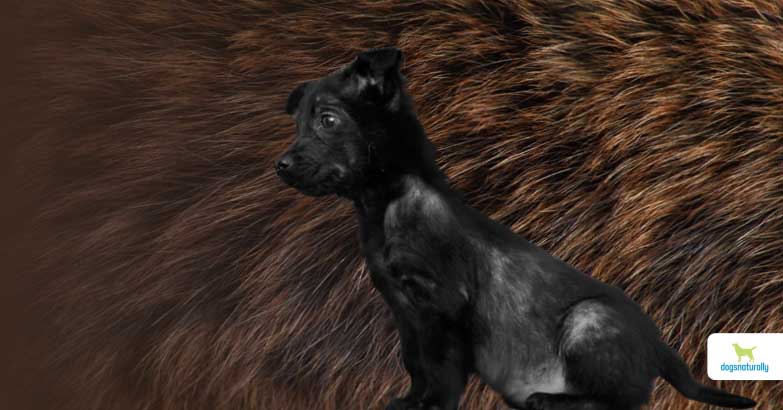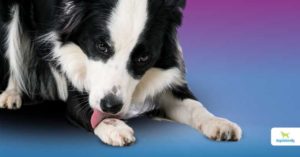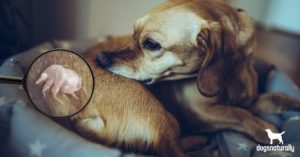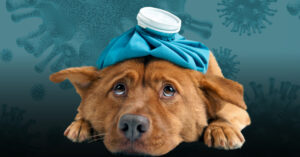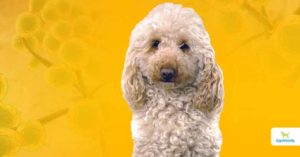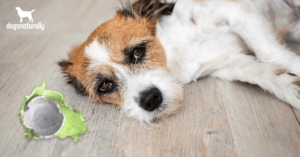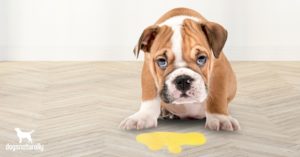Alopecia isn’t just one disease. Alopecia means abnormal hair loss in dogs. There are many reasons for it and many types of alopecia. The hair follicle becomes damaged by infection, inflammation, or other causes below the surface that aren’t apparent.
Alopecia can show itself as specific areas of hair loss, sporadic missing hair, or even hair loss on one side of the body or the other. Sometimes it’s cosmetic and doesn’t affect your dog’s health. But that isn’t always the case. Hair loss is common in dogs, but bald spots in your dog’s fur may be a warning sign of infection or disease.
Symptoms Of Alopecia In Dogs
Hair loss might be fairly obvious, but there are other symptoms beyond the missing hair. They include:
- Dandruff
- Itchy skin
- Patches of dark skin
- Brittle or dry coat
- Shedding more than usual bald patches
- Crusting or red patches around the bald patches
- Inflammation around bald patches
Causes Of Alopecia In Dogs
Alopecia can be congenital or acquired (1).
In congenital hair loss, dogs are born with hair follicles that don’t develop normally.
Acquired hair loss happens when your dog was born with a normal coat, but disease has affected the hair follicles, leading to hair loss. That’s when hair loss is a symptom of other underlying conditions. And that’s when you may want to ask your vet to examine your dog, to make sure he doesn’t have more serious health issues.
Any time there’s a disruption in the growth of the hair follicles it can lead to hair loss. These disruptions include:
- Trauma such as a burn or repeated action like scratching or chewing
- Infection that damages the hair shaft
- Autoimmune disease where hair follicles are destroyed by the immune system
- Endocrine system abnormalities like Cushing’s or hypothyroidism
- Inflammation that can damage the hair follicles
- Allergic reactions – to food or environmental substances
- Poor diet, which can lead to loss of vibrancy and hair loss in dogs
- Parasites like fleas – these lead to intense itching and chewing
- Overgrooming – dogs excessively groom to address stress or pain
Here are 5 health issues that can cause alopecia:
1. Cushing’s Disease
This is when the adrenal glands overproduce the stress hormone cortisol (also called hyperadrenocorticism). Cushing’s can stem from a tumor on the adrenal or pituitary gland … or sometimes from steroid treatment for another issue. It can lead to symmetrical hair loss over the body. This hair loss is a well-known symptom of Cushing’s (2).
2. Hypothyroidism
When the thyroid gland (3) (6) doesn’t produce enough thyroid hormone (hypothyroidism), it can cause a low rate of hair growth that can lead to alopecia. You’ll normally see it on both sides of the body.
3. Yeast
Skin provides a nourishing, warm environment for candida (4) … yeast. Once established, a yeast infection can lead to more serious health issues like a weakened immune system, digestive issues and inflammation, not to mention the itching and discomfort it will cause your dog. The itching and trauma from scratching can lead to hair loss … and it can spread to other parts of the body.
4. Demodectic Mange
Demodex canis is a parasite that takes hold when there’s a weakened immune system. This type of mange can be localized in specific areas or throughout the entire body.
5. Ringworm
Ringworm is a fungal infection of the hair follicle. If it’s the cause, there will be circular flaky, red, hairless patches.
There are many types of alopecia so you need to know which one your dog has before you can manage it.
Types Of Alopecia In Dogs
If your dog has worrisome hair loss, here are types of alopecia, divided into 3 categories: genetic, acquired and trauma-induced alopecia.
1. Genetic Alopecia
There are breeds that have localized baldness on the back of their hind legs, armpits, around the ear bases and on the top of the head. These breeds include the American Hairless Terrier, Whippet and Greyhound.
Here are other genetic disorders that result in alopecia.
Pattern Baldness
This is a noninflammatory type of alopecia. You’ll see a thinning of the coat in the ears, neck, head, and chest. Sometimes there’s darkening of the visible skin. Dachshunds are susceptible but it’s also seen in Chihuahuas, Boston Terriers, Irish Water Spaniels, Whippets and Bull Terriers.
Black Hair Follicular Dysplasia
This genetic disorder is notable for hair loss that occurs in tricolor and bicolor dogs in their black-haired areas. It’s rare and it’s noninflammatory. It can affect breeds like the Bearded Collie, Gordon Setter and Saluki.
Color Dilution Alopecia (CDA)
The color of the coat is also a genetic factor that can lead to alopecia. Dilute colors (5) seen in silver Labs and blue Dobermans have a gene mutation that produces large clumps of pigment. This can cause breakage in the hair shafts leading to alopecia and a thin coat. There may also be flaky or itchy skin. CDA is most often seen in dogs with a blue or fawn coat.
Follicular Dysplasia
This is genetic and affects specific breeds. Dogs will have a poor quality coat that appears moth-eaten. Color dilution alopecia and follicular lipidosis are specific forms of follicular dysplasia.
2. Acquired Alopecia
There are a number of skin and health conditions that can lead to alopecia in dogs.
Seasonal Flank Alopecia
This is a cosmetic type of alopecia (3) that usually appears in the winter. There’s a lack of hair on one or both flanks and there’s no sign of skin disease. It appears dogs afflicted most often are Boxers, Dobermans, and English Bulldogs.
Alopecia X
Also uncommon, alopecia X is a cosmetic condition that appears symmetrically around the body, most often on the trunk, tail and neck (7). You’ll also see darkened skin. Although there is no confirmed cause (thus the “X”), it could be related to abnormal levels of sex hormones.
Alopecia Areata
This is an autoimmune disease where there are focal areas of hair loss. It’s rare and doesn’t usually have inflammation. It appears on the head and neck of dogs.
Post-injection Alopecia
Hair loss in specific areas appears as an inflammatory reaction to rabies (8) and steroid injections. This is common in small breed dogs such as Bichon Frises and Toy or Miniature Poodles. This is mainly a cosmetic issue.
Seborrhea
When the skin’s sebaceous glands produce too much sebum, it leads to oily, scaly skin. It blocks the hair follicles and prevents hair growth.
Pinnal Alopecia
This is restricted to the ear flaps, where hair loss is caused when the hair gets finer and finer in this area.
3. Alopecia From Trauma
This is when a repeated action like scratching creates inflammation that leads to hair loss.
Pyoderma
When dogs persistently lick or scratch a wound or bite, it can lead to inflammation and bacterial skin infection, and damage to hair follicles. And that can lead to hair loss.
Flea Allergy Dermatitis
Dogs with an allergic reaction to flea saliva can become very itchy and have very irritated skin. Persistent scratching and biting lead to hair loss.
Post-Clipping Alopecia
Occasionally you will see this when some dogs are shaved, and the fur does not grow back. The cause is unknown.
Traction Alopecia
This is when owners use clips, ties or barrettes to hold their dog’s hair. If done long-term and pulled too hard on the hair follicles, it can cause alopecia.
How to Diagnose Alopecia In Dogs
Because hair loss can be a symptom of something more serious, you’ll want to get a veterinary diagnosis to know what you might be dealing with. Your vet can do skin scrapings for parasites along with a physical examination, blood tests and skin cultures or biopsies. There are so many types and reasons for alopecia that there may not be a specific test but many can be ruled out once the symptoms are considered.
Is Alopecia Contagious?
Hair loss itself is not contagious. But when alopecia is caused by parasites like fleas or demodex mange, or bacterial or fungal infections, these things may be transmitted to other animals or people.
How to Manage Alopecia
Treating alopecia is challenging … not because it is difficult to control … but because there are so many types. Each condition needs to be evaluated independently depending on the cause.
- Most types of alopecia are treatable or manageable with natural methods like supportive supplements, a change in environment, a better diet and minimizing chemical and drug use.
- Using natural flea and parasite control minimizes hair loss from allergic reactions to bites.
- Alopecia that is due to a genetic or autoimmune disorder can be minimized by making healthy food choices and avoiding toxic chemicals in your dog’s environment.
Some types of alopecia are cosmetic and don’t affect your dog’s health. Here are some things you can do to help your dog’s alopecia, whatever the cause.
Diet
Food is always the starting point in boosting your dog’s health. Especially if your dog has a chronic condition like alopecia, feed the very best diet you can. This means giving your dog a fresh, whole food, raw meat diet (or gently cooked if you can’t do raw) … instead of processed foods that are high in starches dogs don’t need.
World-renowned animal nutritionist Dr Richard S Patton PhD explains the problems with starches in a dog’s diet. And here’s what he has to say about raw diets for dogs:
“To the extent that budget permits, include raw food in your pet’s diet.Your pet’s vitality will be louder and longer, medical bills lower (gum health much improved), and both you and your pet will be happier.”
Dr. Richard S Patton PhD
Melatonin
Many veterinary dermatologists will recommend melatonin for dogs with alopecia. Studies have found melatonin (9) (10) can be used to counter the effects of hormone disruption that lead to hair loss. This is when hair advances too quickly through the growth stage and directly to the hair loss stage. It’s also thought the antioxidant qualities of melatonin can protect hair follicles from oxidative stress of the environment that can lead to hair loss.
Omega-3 Fatty Acids
Omega-3 fatty acids have proven benefits for skin and coat (11, 12). MM McCusker et al at University of Connecticut Health Center noted the skin healing benefits of omega-3 and omega-6 fatty acids in a 2010 study:
“These fatty acids are showing promise as safe adjunctive treatments for many skin disorders, including atopic dermatitis, psoriasis, acne vulgaris, systemic lupus erythematosus, nonmelanoma skin cancer, and melanoma.”
MM McCusker et al. Department of Dermatology University of Connecticut Health Center
And a review at several Taiwanese universities published in 2018 said: “Fish oil and the related actives, such as omega-3 and omega-6 PUFAs, have proved helpful for maintaining skin homeostasis and ameliorating cutaneous abnormalities.“
But the same researchers also suggested fish oil might not be the best source of omega-3 fatty acids, observing that “…there have been conflicting reports from meta-analysis and systematic review regarding the clinical benefit of using fish oil over the control or other lipids. Fish oil is a crude extract with very complex ingredients. It is difficult to control fish oil contents well. The abundant sources of the fish genus also complicate the quality control.”
Fish oil is unstable and can easily go rancid. And it’s not environmentally sustainable. So there are better options to give your dog omega-3s that will support his skin and coat health. One such option is green lipped mussel oil that’s sustainably produced.
RELATED: Read more about the pros and cons of fish oil, plus other alternatives …
So if your dog has been shedding more than usual and is showing bald patches, determine what type of alopecia he has. Once you know what it is, you can find a natural path to bring relief and return your dog to a state of fur and happiness.
References
- Favrot, C. Alopecia in dogs. National Veterinary Internal Medicine Congress. Antalya, Turkey, 08 May 2011 – 08 May 2011.
- Frank, Linda A. Growth hormone-responsive alopecia in dogs. Journal AVMA. May 2005, Vo. 226, No. 9, pgs 1494-1497.
- Daminet S, Paradis M. Evaluation of thyroid function in dogs suffering from recurrent flank alopecia. Can Vet J. 2000 Sep; 41(9):699-703.
- Lee, Hyun-A, et al. Mural Folliculitis and Alopecia with Cutaneous Candidiasis in a Beagle Dog. Lab Animal Research. 2011. Mar;27(1):63-65. v.27(1).
- Kim, Hoon Jae, et al. Color-dilution alopecia in dogs. Journal of Veterinary Science. 2005; 6(3): 259-261.
- Baker, Kenneth. Hormonal alopecia in dogs and cats. In Practice. March 1986. Vo. 8, Issue 2. Pgs 71-78.
- Paradis, Manon, DVM. Alopecia ‘X’. Br. Vet Derm Study Group. 2002.
- Wilcock BP, Yager JA. Focal cutaneous vasculitis and alopecia at sites of rabies vaccination in dogs. Journal AVMA. 1986 May; 188(10):1174-1177.
- Fischer TW, Trüeb RM, Hänggi G, Innocenti M, Elsner P. Topical melatonin for treatment of androgenetic alopecia. Int J Trichology. 2012;4(4):236-245.
- Kim JB, Jung JY, Ahn JC, Rhee CK, Hwang HJ. Antioxidant and anti-apoptotic effect of melatonin on the vestibular hair cells of rat utricles. Clin Exp Otorhinolaryngol. 2009;2(1):6-12. doi:10.3342/ceo.2009.2.1.6.
- TD Watson. Diet and skin disease in dogs and cats. J Nutr. 1998 Dec;128(12 Suppl):2783S-2789S.
- Linus Pauling Institute, Micronutrient Information Center. Esssential Fatty Acids And Skin Health. Oregon State University. February 2012.
- McCusker MM, Grant-Kels JM. Healing fats of the skin: the structural and immunologic roles of the omega-6 and omega-3 fatty acids. Clin Dermatol. 2010 Jul-Aug;28(4):440-51.
- Huang TH, Wang PW, Yang SC, Chou WL, Fang JY. Cosmetic and Therapeutic Applications of Fish Oil’s Fatty Acids on the Skin. Mar Drugs. 2018;16(8):256. Published 2018 Jul 30.

